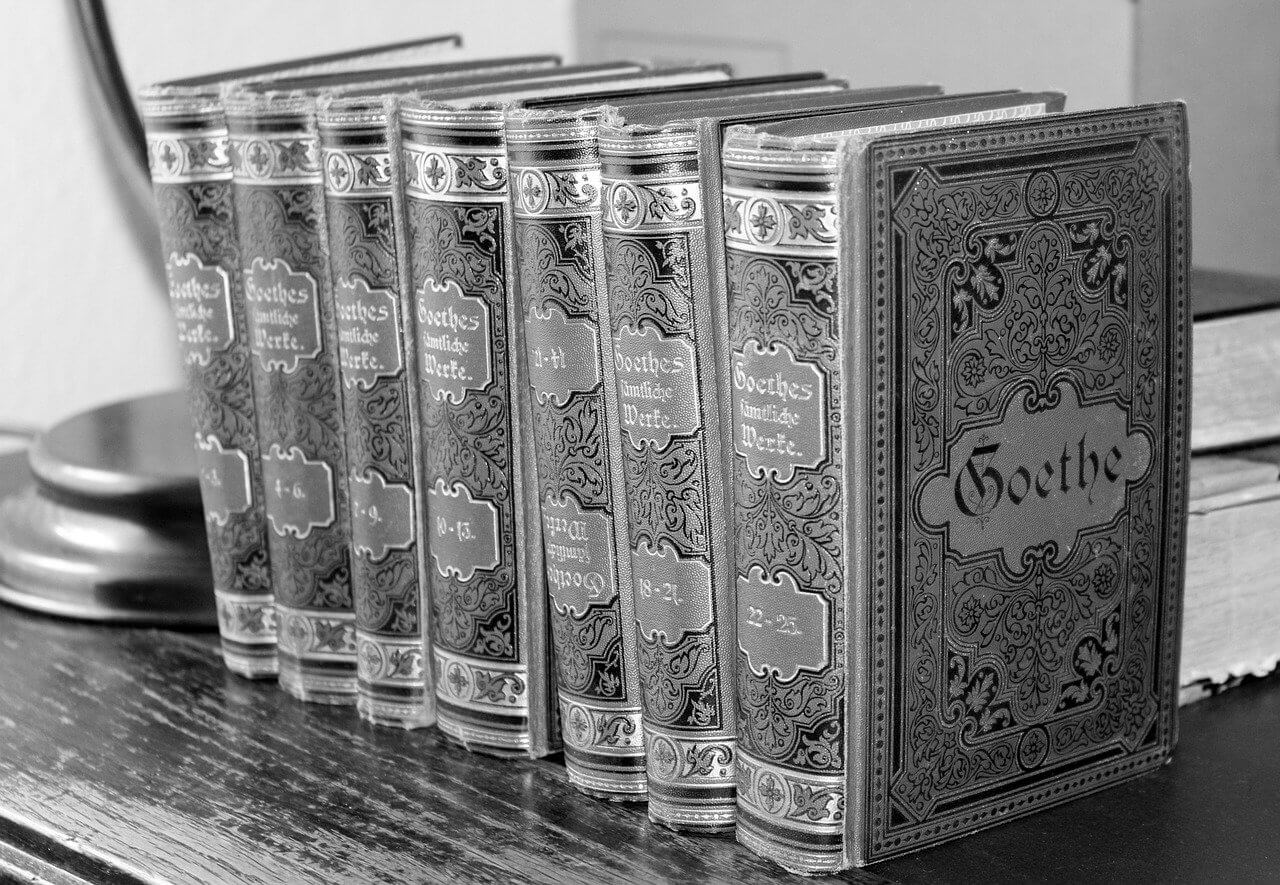What are Johann Wolfgang von Goethe works? Information about Johann Wolfgang von Goethe books, poems, novels and dramas.
Johann Wolfgang von Goethe Works;
Poems.
Goethe’s poetry, equally remarkable for its imaginative power, thematic range, and variety of form, was often written in direct response to specific occasions. From his time in Leipzig, as Goethe explains in Poetry and Truth, he regularly transposed his immediate concerns into pictures or poems in order to verify observations and to achieve composure, so that his lyrics were “fragments of a great confession” that his autobiographical writings would seek to complete. His poems thus afford insight into every aspect of the personality and thought of a poet of unrivaled versatility.
Hermann and Dorothea, composed in unrhymed dactylic hexameters, depicts events in the lives of ordinary people. Its contemporary idiom made the work accessible to all classes of readers. The finest example of popular classicism in modern literature, it reflects the mature Goethe’s tolerant political wisdom and his understanding of the deepest springs of human behavior. Longfellow’s Evangeline is one of many attempts inspired by this work to create a modern equivalent of ancient epic.
Major Dramas.
Faust, a tragedy chiefly in verse, utilizes a broad variety of styles to underscore its theme of total human experience. Seeking self-fulfillment in the realms of thought and action, the Renaissance scholar Faust defies Mephistopheles, who represents the spirit of negation, to provide him with any lasting satisfaction. Faust briefly enjoys the love of the simple Margarete who is destroyed by his passion (Part I). But love exerts a redemptive force that helps Faust, who has innate regenerative powers, to realize his full aesthetic-intellectual and political-social potential both in the real world and in dream encounters with important elements of the Western cultural tradition (Part II). Faust, which reflects all of Goethe’s major interests, is his masterpiece and the greatest work of German literature. It has influenced every later treatment of the Faust legend, including analogous works like Byron’s Manfred, and has largely determined the values subsequently attached to the term “Faustian.”

Source : pixabay.com
Götz von Berlichingen, a prose drama, was strongly influenced in its structure by Shakespeare’s histories. The autobiography of Götz von Berlichingen, a 16th century Franconian knight, inspired Goethe to represent the tragic pathos of conservative resistance to governmental centralization. In the play, Götz’s opponent Weislingen is a vacillating courtier, who is enamoured of the attractive but self-seeking Adelheid von Walldorf and sacrifices personal ties to political ambition. Vividly delineated lesser figures and a wealth of episodes create a panoramic picture of German life in the years around the Peasants’ War of 1525.
The central action revolves around Götz’s inability to cope with the forces destroying the old political order. The peasants with whom he allies himself in the hope of moderating revolutionary violence are crushed. Götz dies in prison, aged by forced inactivity and overcome by the end of liberty as he understands it. Weislingen and Adelheid are also destroyed: he is poisoned at her behest; she is executed on the order of a secret tribunal. The work initiated the many dramas of chivalry that flourished through much of the 19th century. It also contributed to the vogue of the historical romance.
Egmont, a tragedy in prose, focuses on the character of the Dutch hero Count Egmont, who was executed at Brussels in 1568. Accuracy of historical detail is sacrificed for dramatic effectiveness. Egmont—young, attractive, and in love with Klärchen, a middle-class girl—symbolizes the political moderate, insufficiently supported by liberals and defenseless against extremists. The climax of the play is Egmont’s confrontation with the authoritarian Duke of Alba, before whom he appears despite the warnings of more cautious opponents of Spanish rule.
Egmont is seized and ordered executed. He accepts death as a sacrifice that will inspire a successful revolt against religious and political oppression. The play ends in his musically accompanied dream-vision of Klarchen (who has committed suicide after vainly trying to organize a popular uprising) as Liberty in an allegorical anticipation of independence finally achieved. Each milieu in the play—the public-popular, the private, and the courtly-political— is depicted with stylized realism. Beethoven’s famous incidental music for Egmont was written in 1810.
Iphigenia on Taurica modernizes the myth of Euripides’ Iphigenia Among the Taurians. The play’s central interest is not whether Orestes will rescue his sister Iphigenia and atone for matricide by bringing back to Attica a statue of Artemis, but how Iphigenia’s nobility of character—her humane idealism and scrupulous honesty—restores her guilt-tormented brother’s self-confidence and wins from their captor, King Thoas, freedom to return home. The play, in polished blank verse, seems Greek in style, with its strict adherence to the unities and its use of only five characters. However, the absence of a chorus and the concentration on ethical and psychological concerns are closer to the tradition of French classical tragedy. Its spirit is that of an enlightened humanitarianism that assumes the innate nobility of all men. The enormity of Iphigenia’s devotion to idealism—a devotion that once led Goethe to describe her as “diabolically humane”—is what, for all the work’s surface calm, gives it dramatic intensity and makes it theatrically vital.
Torquato Tasso, a neoclassical drama in elevated blank verse that is at times richly lyrical and again pithily sententious, examines the psychology of being a poet and, by extension, the poet’s place in society. The honors accorded the poet Tasso by the Duke of Ferrara and his sister the Princess irritate Antonio, the Duke’s chief minister. Antonio’s scorn of all that is “useless” provokes Tasso to draw his sword against him, and for this breach of decorum the poet is confined. However, the Princess, supported by Antonio, quickly obtains his release.
Despite the Duke’s obvious benevolence, Tasso feels persecuted and distrusts all who show concern for him, even the Princess whom he secretly loves. Misinterpreting her effort to convince him of her sincerity, he embraces her publicly. Now placed in Antonio’s charge, he becomes a withdrawn and broken man whose only freedom is in his poetry. It is to be hoped that he may ultimately regain a sense of reality, here symbolized by Antonio, whose hand he grasps as the play ends. The gradual revelation of character produces great dramatic tension. By endowing his hero with his own lyric genius Goethe creates an unsurpassed portrait of a literary artist.
Novels.
The Sorrows of Young Werther, an epistolary novel, exists in two versions. The definitive text (1787) is somewhat more insistent than the first version that the attractive hero (whom sentimental readers had uncritically idolized) is also seriously disturbed. Werther’s letters give a dramatically structured portrait of a sentimentalist whose lack of direction aggravates a tendency to subjectivism and passivity. Werther’s inability to tolerate alien views and to adapt to society intensifies his aimlessness and isolation. When he finally recognizes how hopeless and destructive is his love for the charmingly natural, somewhat motherly Lotte (who is engaged when he first meets her and whom he overwhelms with his attentions after her marriage), he persuades himself that suicide can be both an act of atonement and a release from a life that has become purposeless. Although many passages are lyric or rhapsodic, there are also lively touches of humor, irony, and satire revealing Goethe’s debt to other traditions—such as the novel of manners, represented by Goldsmith’s The Vicar of Wakefield—than that of the sentimental-pathetic tale that was popular in the 18th century.

Source : pixabay.com
Wilhelm Meister’s Apprenticeship blends elements of the romantic and the satiric-realistic novel (disguises, complex family relationships, even a secret society with educational and economic aims) to lend broad significance to the adventures of a stagestruck youth. Wilhelm gradually matures through association with people of every social class, who represent a wide spectrum of moral and intellectual values. The pi ay wright-actor’s enthusiasms surpass his talents, as he discovers on playing Hamlet, but he finally learns to accept his limitations and responsibilities. At the end of the novel, Wilhelm is welcomed into the Society of the Tower as worthy of medical training and wins the hand of a young woman in whom his own long conflicting impulses already exist in ideal harmony.
Much of the work’s interest lies in its long conversations on art and life, but many characters are vividly drawn, especially the young dancer Mignon and her harpist father, the actress Philine, and—with often subtle irony—the naive Wilhelm. The combination of a novel of educational development with a novel of ideas makes the work difficult for non-German readers, but its influence can be discerned in every important Bildungsroman (“educational novel”) written since.
Elective Affinities, by virtue of its dispassionate tone and generalizing style, is the most classical of Goethe’s novels. Its title (a chemical term for attraction between elements of different compounds) refers to the relation of the four main characters: Eduard; his friend, a civil engineer; Eduard’s wife, Charlotte; and Ottilie, her adoptive daughter. Charlotte is attracted to the engineer, Eduard to Ottilie, but a fatal chain of events—especially Ottilie’s responsibility in the accidental death of Charlotte’s and Eduard’s child, conceived when both were already in love with their true affinities—prevents a viable rearrangement of the four human elements. Charlotte and the engineer renounce each other, but the less mature Eduard remains hopelessly devoted to Ottilie, who emerges as the central figure of the novel. Her vitality is destroyed just as she is about to become a fully adult human being, and she can cope with guilt only by an extreme asceticism that causes her early death. Hers is the tragedy of unfulfilled human potential. Primarily a psychological study, Elective Affinities also accurately depicts the leisured upper-class milieu to which its figures belong. Every detail is functional in both contexts, producing a symbolic completeness that makes the work comparable with Faust as a full expression of Goethe’s concerned humanism.
Wilhelm Meister’s Travels, or The Renun-ciants is basically a didactic-utopian novel. Its surgeon-hero is a recipient of wisdom rather than (as in his apprentice years) an individual in his own right, so that the work is a sequel to, not a continuation of, his earlier adventures. Wilhelm’s somewhat arbitrarily motivated wanderings permit examination of the discontinuity and uprootedness wrought in early 19th century Germany by social, economic, and other changes incidental to industrial and intellectual revolution. These changes necessitate renunciation, not simply as a private ethical choice but as a policy decision on how the development of the individual can best be achieved within the limits imposed by specialization and technology. The-matically related stories told by figures in the novel insist that renunciation may be imposed by necessity or anticipated by wisdom and foresight. Essayistic passages, dialogue discussions, collections of maxims and aphoristic reflections, and even technical treatises are introduced into the frame narrative, whose complexity seems to parody romantic forms of the Bildungsroman.
Wilhelm’s placing of his son in an experimental school (the “Pedagogical Province”) lets Goethe outline an educational program in which private worth and talent can be developed without detriment to the spirit of enterprise and communal needs. Aspects of Goethe’s social vision have ceased to be immediately applicable. Still relevant, however, are his ideal of a balanced education, his insistence on the dignity of labor and the need of economic rationalization (and a common market), his scorn of sensational and dishonest journalism, his awareness that no specific social problem is likely to be solved permanently, and his reverence for knowledge and wisdom even when the latter transcends the rationally graspable. The novel is thus an ironically diffident agglomerate that by its very indifference to narrative convention fulfills the requirement of Goethe in his later years: “All poetry has to be didactic, for its function is to heighten awareness and permit man to take from it, as from life, the lesson it may teach.”
Other Prose Writings.
The autobiographical works collectively entitled From My Life are more dispassionate in tone than most personal memoirs. Poetry and Truth, especially, records objectively the social, emotional, and intellectual climates in which Goethe came to maturity and often lets their literary conventions color the presentation of stages in his growth. In the accounts of his Italian sojourn the element of the personal memoir is larger, but letters and other contemporaneous materials have been so revised and ordered as to give an objective picture of his broad interests and to show their central importance in his total development. For the French campaigns the method is rather that of the historical memoirist, placing Goethe’s experiences of 1792 and 1793—including his intellectual ones—in large military and political contexts that only later became discernible.

Source : pixabay.com
Goethe’s aesthetic ideas and his literary criticism are scattered through his whole oeuvre—in explanatory notes to individual poems as well as in essays on art, prefaces to journals and books, and book reviews. Especially important are his commentary on Diderot’s dialogue Rameau’s Nephew (1805, with his translation from the unpublished French), the appendices to his West-Easterly Divan, and Correspondence Between Schiller and Goethe in the Years 1794 to 1805 (6 vols., 1828-1829).
The scientific writings range from short essays on methodology to a survey of color theory since antiquity, a study that relates intellectual history to the history of science instead of to that of philosophy, as had been customary. His scientific writings document extensive knowledge of and active work in physics, geology (mineralogy, paleontology, seismology, and glaciology), meteorology, zoology (comparative anatomy, entomology and osteology), and botany (plant physiology, and morphology)—all reflecting Goethe’s lofty vision of a totally integrated natural order of being. For discussions of individual works, see Index entry Goethe.